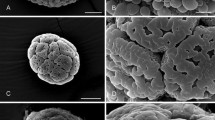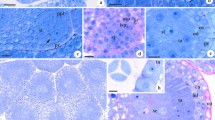Abstract
This paper reviews the origin, nature, systematic distribution, and the respective function of the highly variable and diverse thread-forming structures in angiosperm anthers (including somewhat similar, rare features in ferns and gymnosperms). On one hand, such threads may function as pollen-connecting vectors in forming pollen dispersal units, as sporopollenin threads (viscin threads), e.g. in Onagraceae, or sporopollenin-less threads in surprisingly many other angiosperm families. On the other hand, as is known from theImpatiens — “pollen basket”, threads or ropes may be involved in pollen presentation. In addition, for the first time two new examples of “pollen baskets” in Boraginaceae and Scrophulariaceae are reported. InEchium the basket is formed by cellular elements from the modified septal regions, whereas inEsterhazya a similar effect is achieved in an analogous manner by trichomes of the epidermal layer of the thecal wall. There is obviously a different function of these seemingly very similar baskets: inEchium the feature acts preferably as a pollen presentation agent, whereas inEsterhazya the primary function is to prevent all the pollen from being dispersed too soon.
Similar content being viewed by others
References
Ackerman J. D., Williams N. H. (1981) Pollen morphology of theChloraeinae (Orchidaceae: Diuridae) and related subtribes. Amer. J. Bot. 68: 1392–1402.
Beck v. Mannagetta G. (1895) Orobanchaceae. In: Engler A., Prantl K. (eds.) Die Natürlichen Pflanzenfamilien IV, 3b. Engelmann, Leipzig.
Burns-Balogh P., Funk V. A. (1986) A phylogenetic analysis of the Orchidaceae. Smithsonian Contr. Bot. 61: 1–79.
Burns-Balogh P., Hesse M. (1988) Pollen morphology of the cypripedioid orchids. Plant Syst. Evol. 158: 165–182.
Buzato S., Franco A. L. M. (1992)Tetrastylis ovalis: a second case of bat-pollinated passionflower (Passifloraceae). Plant Syst. Evol. 181: 261–267.
Canne-Hilliker J. M. (1987) Patterns of floral development inAgalinis and allies (Scrophulariaceae) II. Floral development ofAgalinis densiflora. Amer. J. Bot. 74: 1419–1430.
Cox P. A., Knox R. B. (1989) Two-dimensional pollination in hydrophilous plants: convergent evolution in the generaHalodule (Cymodoceaceae),Halophila (Hydrocharitaceae),Ruppia (Ruppiaceae), andLepilaena (Zannichelliaceae). Amer. J. Bot. 76: 164–175.
Cox P. A., Tomlinson P. B. (1988) Pollination ecology of a seagrass,Thalassia testudinum (Hydrocharitaceae), in St. Croix. Amer. J. Bot. 75: 958–965.
Crepet W. L. (1996) Timing in the evolution of derived floral characters: Upper Cretaceous (Turonian) taxa with tricolpate and tricolpatederived pollen. Rev. Palaeobot. Palynol. 90: 339–359.
Dannenbaum C., Schill R. (1991) Die Entwicklung der Pollentetraden und Pollinien bei den Asclepiadaceae. Bibliotheca Botanica 141: 138
Dressler R. L. (1993) Phylogeny and classification of the orchid family. Cambridge University Press, Cambridge.
Endress P., Hufford L. S. (1989) The diversity of stamen structures and dehiscence patterns among Magnoliidae. Bot. J. Linnean Soc. 100: 45–85.
Endress P., Stumpf S. (1991) The diversity of stamen structures in Lower Rosidae (Rosales, Fabales, Proteales, Sapindales). Bot. J. Linnean Soc. 107: 217–293.
Halbritter H. (1998) Preparing living pollen material for Scanning Electron Microscopy using 2,2-Dimethoxypropane (DMP) and Critical-Point Drying. Biotech. Histochem. 73: 137–143.
Halbritter H., Hesse M., Buchner R. (1997) Pollenconnecting threads inGymnocalycium (Cactaceae): their origin, function, and systematic relevance. Grana 36: 1–10.
Hartl D. (1972) Scrophulariaceen II. In: Hegi, Illustrierte Flora von Mitteleuropa VI. Carl Hanser Verlag, Stuttgart.
Hesse M. (1986) Nature, form and function of pollen-connecting threads in angiosperms. In: Blackmore S., Ferguson I. K. (eds.) Pollen and Spores. Form and Function. Academic Press, London Orlando San Diego New York Austin Boston Sydney Tokyo Toronto, pp. 109–118.
Hesse M., Burns-Balogh P. (1984) Pollen and pollinarium morphology ofHabenaria (Orchidaceae). Pollen Spores 26: 385–400.
Keri C., Zetter R. (1992) Notes on the exine ultrastructure of Onagraceae and Rhododendroideae (Ericaceae). Grana 31: 119–123.
King M. J., Buchmann S. L. (1995) Bumble bee-initiated vibration release mechanism ofRhododendron pollen. Amer. J. Bot. 82: 1407–1411.
Knox R. B., McConchie C. A. (1986) Structure and function of compound pollen. In: Blackmore S., Ferguson I. K. (eds.) Pollen and Spores. Form and Function. Academic Press, London Orlando San Diego New York Austin Boston Sydney Tokyo Toronto, pp. 265–282.
Knuth P. (1899) Handbuch der Blütenbiologie II, 2. Engelmann, Leipzig.
Kraemer M., Schmitt U. (1997) Nectar production patterns and pollination of the Canarian endemicEchium wildpretii Pearson ex Hook fil. Flora 192: 217–221.
Kronestedt-Robards E. (1996) Formation of the pollen-aggregating threads inStrelitzia reginae. Ann. Bot. 77: 243–250.
Kurmann M. H., Zavada M. S. (1994) Pollen morphological diversity in extant and fossil gymnosperms. In: Kurmann M. H., Doyle J. A. (eds.) Ultrastructure of Fossil Spores and Pollen. The Royal Botanic Gardens, Kew, pp. 123–137.
Mayo S. J., Bogner J., Boyce P. C. (1997) The genera of Araceae. The Royal Botanic Gardens, Kew.
Morawetz W., Waha M. (1991) Zur Entstehung und Funktion pollenverbindender Fäden beiPorcelia (Annonaceae). Beitr. Biol. Pflanzen 66: 145–154.
Nixon K. E., Crepet W. L. (1993) Late Cretaceous fossil flowers of ericalean affinity. Amer. J. Bot. 80: 616–623.
Pacini E., Franchi G. G. (1996) Some cytological, ecological and evolutionary aspects of pollination. Acta Soc. Bot. Pol. 65: 11–16.
Pacini E., Franchi G. G. (1998) Pollen dispersal units, gynoecium and pollination. In: Owens S. J., Rudall P. J. (eds.) Reproductive Biology. The Royal Botanic Gardens, Kew, pp. 183–195.
Pacini E., Franchi G. G. (1999) Types of pollen dispersal units and pollen competition. In: Clément C., Pacini E., Audran J.-C. (eds.) Anther and Pollen. From Biology to Biotechnology. Springer, Berlin Heidelberg New York, pp. 1–11.
Patel V., Skvarla J. J., Ferguson I. K., Graham A., Raven P. H. (1985) The nature of threadlike structures and other morphological characters inJacqueshuberia pollen (Leguminosae: Caesalpinioideae). Amer. J. Bot. 72: 407–413.
Pettitt J. M. (1981) Reproduction in seagrasses: pollen development inThalassia hemprichii, Halophila stipulacea andThalassodendron ciliatum. Ann. Bot. 48: 609–622.
Pinheiro M. C., Teixeira Ormond W., Alves de Lima H., Rodrigues Correia M. C. (1995) Biologia da reproducao deNorantea brasiliensis Choisy (Marcgraviaceae). Rev. Brasileira Biol. 55 [Suppl. 1]: 79–88.
Richter S. (1929) Über den Öffnungsmechanismus der Antheren bei einigen Vertretern der Angiospermen. Planta 8: 154–184.
Rose M.-J., Barthlott W. (1995) Pollen-connecting threads inHeliconia (Heliconiaceae). Plant Syst. Evol. 195: 61–65.
Rowley J. R. (1987) Plasmodesmata-like processes of tapetal cells. La Cellule 74: 229–241.
Sazima I., Buzato S., Sazima M. (1993) The bizarre inflorescence ofNorantea brasiliensis (Marcgraviaceae): visits of hovering and perching birds. Bot. Acta 106: 507–513.
Schill R., Wolter M. (1986) On the presence of elastoviscin in all subfamilies of the Orchidaceae and the homology to pollenkitt. Nordic J. Bot. 6: 321–324.
Shukla A. K. (1984) A clarification on the use of the term viscin thread in Orchidaceae. Grana 23: 127.
Skvarla J. J., Raven P. H., Chissoe W. F., Sharp M. (1978) An ultrastructural study of viscin threads in Onagraceae. Pollen Spores 20: 5–144.
Skvarla J. J., Raven P. H., Praglowski J. (1975) The evolution of pollen tetrads in Onagraceae. Amer. J. Bot. 62: 6–35.
Trevisan L. (1971)Dicheiropollis, a pollen type from Lower Cretaceous sediments of southern Tuscany (Italy). Pollen Spores 13: 561–596.
Troll W. (1928) ÜberSpathicarpa sagittifolia Schott. Flora 123: 286–316.
Tryon A. F. (1986) Stasis, diversity and function in spores based on an electron microscope survey of the Pteridophyta. In: Blackmore S., Ferguson I. K. (eds.) Pollen and spores. Form and Function. Linnean Soc. Symp. Series 12: 234–249.
Vijayaraghavan M. R., Shukla A. K. (1980) Viscin threads inZeuxine strateumatica (Orchidaceae). Grana 19: 173–175.
Vogel S. (1959) Organographie der Blüten kapländischer Ophrydeen mit Bemerkungen zum Koaptations-Problem. Teil I:Disinae undSatyrinae. Akademie der Wissenschaften und Literatur, Abhandlungen der mathematisch-na-turwissenschaftlichen Klasse, Jahrgang 1959, Nr. 6. Verlag der Akademie der Wissenschaften und der Literatur in Mainz, in Kommission bei Franz Steiner Verlag GmbH. Wiesbaden.
Vogel S., Cocucci A. (1988) Pollen threads inImpatiens: Their nature and function. Beitr. Biol. Pflanzen 63: 271–287.
Waha M. (1984) Zur Ultrastruktur und Funktion pollenverbindender Fäden bei Ericaceae und anderen Angiospermenfamilien. Plant Syst. Evol. 147: 189–203.
Wallace G. D. (1975) Interrelationship of the subfamilies of the Ericaceae and derivation of the Monotropoideae. Bot. Not. 128: 286–298.
Weber M., Halbritter H., Hesse M. (1998) The spiny pollen wall inSauromatum (Araceae) — with special reference to the endexine. Int. J. Plant Sci. 159: 744–749.
Willemstein S. C. (1987) An evolutionary basis for pollination ecology. Leiden University Press, Leiden.
Wolter M., Seuffert C., Schill R. (1988) The ontogeny of pollinia and elastoviscin in the anther ofDoritis pulcherrima (Orchidaceae). Nordic J. Bot. 8: 77–88.
Yeo P. (1993) Secondary Pollen Presentation. Form, Function and Evolution. Plant Syst. Evol. [Suppl.] 6: 1–268.
Zetter R., Hesse M. (1996) The morphology of pollen tetrads and viscin threads in some Tertiary,Rhododendron-like Ericaceae. Grana 35: 285–294.
Author information
Authors and Affiliations
Rights and permissions
About this article
Cite this article
Hesse, M., Vogel, S. & Halbritter, H. Thread-forming structures in angiosperm anthers: Their diverse role in pollination ecology. Pl Syst Evol 222, 281–292 (2000). https://doi.org/10.1007/BF00984107
Received:
Accepted:
Issue Date:
DOI: https://doi.org/10.1007/BF00984107




